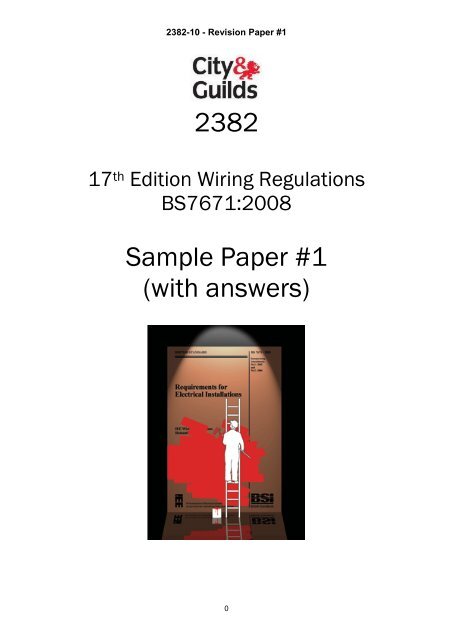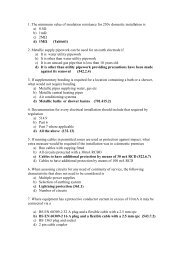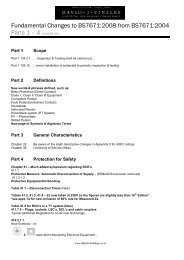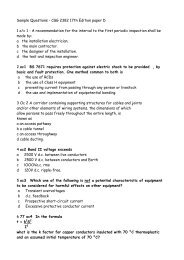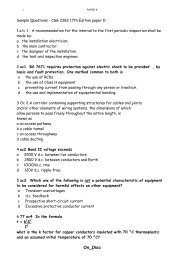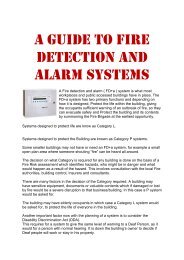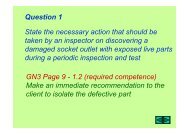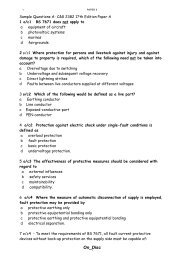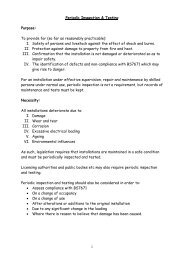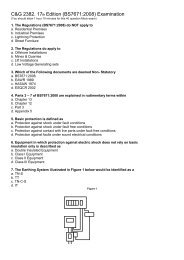2382 Sample Paper #1 - DJT Electrical Engineering Consultancy ...
2382 Sample Paper #1 - DJT Electrical Engineering Consultancy ...
2382 Sample Paper #1 - DJT Electrical Engineering Consultancy ...
Create successful ePaper yourself
Turn your PDF publications into a flip-book with our unique Google optimized e-Paper software.
<strong>2382</strong>-10 - Revision <strong>Paper</strong> <strong>#1</strong><br />
<strong>2382</strong><br />
17 th Edition Wiring Regulations<br />
BS7671:2008<br />
<strong>Sample</strong> <strong>Paper</strong> <strong>#1</strong><br />
(with answers)<br />
0
<strong>2382</strong>-10 - Revision <strong>Paper</strong> <strong>#1</strong><br />
1. BS7671 applies to<br />
a) Systems for distribution of electricity<br />
to the public<br />
b) Railway traction equipment<br />
c) Equipment on board ships<br />
d) Construction sites<br />
2. The scope of BS7671 does not apply<br />
to<br />
a) Residential premises<br />
b) Fixed offshore installations<br />
c) Commercial premises<br />
d) Photovoltaic systems<br />
3. For installations in places of public<br />
entertainment and on caravan parks,<br />
special requirements should be<br />
ascertained from the<br />
a) Department for trade and Industry<br />
b) Health and safety Executive<br />
c) Local licensing authority<br />
d) Energy Institute<br />
4. It should be verified that any addition<br />
to an existing installation has<br />
a) A supply separate from that of the<br />
existing installation<br />
b) A similar wiring system to that used in<br />
the existing installation<br />
c) Been treated as being entirely<br />
separate from the existing installation<br />
d) Not impaired the safety of the existing<br />
installation<br />
5. An extraneous-conductive-part may<br />
be defined as<br />
a) Conductive part of equipment which<br />
may be touched and which is not<br />
normally live, but which can become<br />
live when basic insulation fails<br />
b) Conductive part liable to introduce a<br />
potential and not forming part of the<br />
electrical installation<br />
c) Equipment designed to be fastened to<br />
a support or otherwise secured in a<br />
specific location<br />
d) A room or location in which air is<br />
heated, in service, to high<br />
temperatures<br />
6. Protection against electric shock<br />
under single fault conditions is<br />
a) Basic protection<br />
b) Fault protection<br />
c) Additional protection<br />
d) Supplementary protection<br />
7. The symbol used to denote design<br />
current is<br />
a) I b<br />
b) I n<br />
c) I t<br />
d) I 2<br />
8. A nominal voltage of 120V ac would<br />
be categorised as<br />
a) Band I<br />
b) Low voltage<br />
c) Extra-low voltage<br />
d) High voltage<br />
1
<strong>2382</strong>-10 - Revision <strong>Paper</strong> <strong>#1</strong><br />
9. In order to mitigate the effects of<br />
electromagnetic interferences (EMI)<br />
an installation should<br />
a) Be wired in pvc cable in conduit or<br />
trunking<br />
b) Have all magnetically controlled<br />
circuits connected to the same<br />
protective device<br />
c) Be divided into circuits<br />
d) Have a notice stating ‘EMI’ present<br />
10. An electrical installation has the<br />
following single-phase circuits<br />
installed, using multi-core<br />
thermoplastic non-armoured cables.<br />
a) 6<br />
b) 8<br />
c) 16<br />
d) 24<br />
2 x 6A lighting<br />
2 x 32A ring final<br />
1 x 16A water heater<br />
1 x 32A cooker<br />
If the circuits are contained within pvc<br />
trunking prior to entering the<br />
consumer control unit (CCU), how<br />
many live conductors would be<br />
present in the trunking<br />
11. How many types of earthing system<br />
are recognised by BS7671<br />
a) 3<br />
b) 4<br />
c) 5<br />
d) 6<br />
12. Protective device discrimination must<br />
be considered with regard to<br />
a) External influences<br />
b) Continuity of service<br />
c) Maintainability<br />
d) Compatibility<br />
13. The top of an enclosure should have<br />
a minimum degree of protection of<br />
a) IPXXD or IP4X<br />
b) IPXXB or IP2X<br />
c) IP1X<br />
d) IP3X<br />
14. A 6A BSEN60898 circuit breaker is<br />
used to protect a circuit with a<br />
maximum earth fault loop impedance<br />
(Z S ) of 3.83Ù would be type<br />
a) A<br />
b) B<br />
c) C<br />
d) D<br />
15. Which of the following will provide<br />
overload protection<br />
a) Linked switch<br />
b) Residual current device<br />
c) Disconnector<br />
d) Circuit breaker<br />
16. Where there is a danger of fire due to<br />
the nature of the stored material, a<br />
100W spotlight shall be installed at a<br />
minimum distance from combustible<br />
materials of<br />
a) 0.5m<br />
b) 0.8m<br />
c) 1m<br />
d) 2m<br />
17. Suitable precautions should be taken<br />
where either a reduction in voltage or<br />
a loss and subsequent restoration of<br />
voltage<br />
a) Is a routine event<br />
b) Could cause danger<br />
c) Occurs infrequently<br />
d) Will not cause danger<br />
2
<strong>2382</strong>-10 - Revision <strong>Paper</strong> <strong>#1</strong><br />
18. In the event of failure of the provision<br />
for basic protection, additional<br />
protection may be provided by<br />
a) Supplementary bonding<br />
b) The use of a time delayed 100mA<br />
RCD<br />
c) Use of a RCD not exceeding IÄn of<br />
30mA<br />
d) <strong>Electrical</strong> separation<br />
19. The maximum permitted value of<br />
earth electrode and earthing<br />
conductor (RA) for a circuit protected<br />
by a 300mA RCD and forming part of<br />
a 230V ac TT system is<br />
a) 500Ù<br />
b) 100Ù<br />
c) 167Ù<br />
d) 1667Ù<br />
20. Which one of the following would be<br />
used to determine the size of an<br />
overcurrent device<br />
a) Cable size<br />
b) Grouping factor<br />
c) Design current<br />
d) Overload current<br />
21. Fault protection may be provided by<br />
a) Barriers and enclosures to IPXXB or<br />
IP2X<br />
b) Insulation of live parts<br />
c) Protective earthing and protective<br />
equipotential bonding<br />
d) Placing out of reach<br />
22. Where an RCD is used in an<br />
installation, the product of IÄn and the<br />
earth fault loop impedance in a TT<br />
installation should not be greater than<br />
a) 2V<br />
b) 10V<br />
c) 40V<br />
d) 50V<br />
23. Which of the following methods<br />
should be adopted where fixed<br />
equipment having a high surface<br />
temperature is likely to have an<br />
adverse effect on adjacent materials<br />
a) Erection of warning notices advising<br />
high temperatures<br />
b) Mounting so as to allow safe<br />
dissipation of heat<br />
c) The use of non-combustible wiring<br />
materials<br />
d) The provision of suitable fire<br />
extinguishers<br />
24. An overload current could arise<br />
a) During an earth fault<br />
b) During a short-circuit fault<br />
c) When a motor becomes jammed<br />
d) When a shower is switched on<br />
25. To provide protection against electric<br />
shock, the protective measure of<br />
double reinforced insulation relies on<br />
basic insulation and<br />
a) Bonding<br />
b) Connection of exposed metalwork to<br />
the protective conductor<br />
c) Earthing in the fixed wiring of the<br />
installation<br />
d) Supplementary insulation<br />
3
<strong>2382</strong>-10 - Revision <strong>Paper</strong> <strong>#1</strong><br />
26. The earth fault loop impedance (Z S )<br />
for a consumer’s circuit is determined<br />
by<br />
a) R 1 + R 2 – Z e<br />
b) R 1 + R 2 + Z e<br />
c) R 1 + R 2 + R n<br />
d) R 1 + R 2 ÷ Z e<br />
27. A copper earthing conductor not<br />
mechanically protected and not<br />
protected against corrosion is buried<br />
in soil. The minimum size of earthing<br />
conductor is<br />
a) 4mm 2<br />
b) 16mm 2<br />
c) 25mm 2<br />
d) 50mm 2<br />
28. When selecting a cable for a single<br />
circuit installation, rating factors are to<br />
be used and applied to the<br />
a) Total current taken by the installation<br />
b) Current-carrying capacity of the cable<br />
c) Design current of the circuit<br />
d) Rated current of the protective device<br />
29. A suitable supply for safety services is<br />
a<br />
a) Primary cell or cells<br />
b) Standard mains supply<br />
c) Non earthed transformer<br />
d) Mains operated generator<br />
31. A permanent label with the words<br />
‘Safety <strong>Electrical</strong> Connection – Do Not<br />
Remove’ shall be permanently fixed<br />
a) At the point of connection between<br />
the earthing conductor to an earth<br />
electrode<br />
b) At the main earthing terminal which is<br />
incorporated within the main<br />
switchgear<br />
c) At the point of connection between<br />
the earthing and PEN conductor of a<br />
TN-C-S system<br />
d) At the point of connection of to an<br />
exposed-conductive-part<br />
32. A conduit or cable trunking system<br />
classified as non-flame propagating<br />
need not be internally sealed<br />
providing its maximum cross-sectional<br />
area does not exceed<br />
a) 625mm 2<br />
b) 710mm 2<br />
c) 1250mm 2<br />
d) 2500mm 2<br />
33. Where practical, the main protective<br />
equipotential bonding to the gas<br />
service in a building should be made<br />
within<br />
a) 3m of the meter on the supply side<br />
b) 3m of the meter on the consumer side<br />
c) 600mm of the meter on the supply<br />
side<br />
d) 600mm of the meter on the consumer<br />
side<br />
30. Non-sheathed cables for fixed wiring<br />
installations should be<br />
a) Thermosetting<br />
b) Thermoplastic<br />
c) Enclosed in conduit or trunking<br />
d) A minimum of 4mm 2 cross-sectional<br />
area<br />
34. Every fire-fighter switch should be<br />
a) Coloured red with the off position at<br />
the top<br />
b) Coloured red with the off position at<br />
the bottom<br />
c) Installed in the high-voltage circuit<br />
d) Mounted at a minimum height of 3m<br />
4
<strong>2382</strong>-10 - Revision <strong>Paper</strong> <strong>#1</strong><br />
35. An RCD that is installed for protection<br />
against the risk of fire must be<br />
a) Integral to and socket-outlet<br />
b) Installed at the origin of the circuit<br />
c) Rated at 500mA<br />
d) Arranged to switch line conductors<br />
only<br />
36. The diagram below illustrates which<br />
type of earthing system<br />
38. Socket-outlets with a rated current not<br />
exceeding 20A and intended to be<br />
used by ordinary persons should be<br />
a) Protected by an RCD with an<br />
operating current not exceeding 30mA<br />
b) Protected by an RCD with an<br />
operating current not exceeding<br />
100mA<br />
c) Protected by an RCD with an<br />
operating current not exceeding<br />
300mA<br />
d) Protected by an RCD with an<br />
operating current not exceeding<br />
500mA<br />
a) TN-C-S<br />
b) TN-C<br />
c) TT<br />
d) TN-S<br />
37. Referring to the diagram below the<br />
conductor marked ‘X’ is a<br />
a) Circuit protective conductor<br />
b) Earthing conductor<br />
c) Main protective bonding conductor<br />
d) Supplementary bonding conductor<br />
39. A single-phase circuit using 2.5mm 2<br />
single-core pvc cables in conduit<br />
supplies a design current of 20A. If<br />
the cables are 15m long and have a<br />
rated voltage drop of 18mV/A/m, the<br />
actual voltage drop will be<br />
a) 2.5V<br />
b) 5.4V<br />
c) 6V<br />
d) 16.6V<br />
40. For reason of external influences, any<br />
outdoor lighting installation must have<br />
a degree of protection of at least<br />
a) IP22<br />
b) IP24<br />
c) IP33<br />
d) IP44<br />
X<br />
41. Which of the following is not allowed<br />
for use as a circuit protective<br />
conductor<br />
a) Galvanised metallic conduit<br />
b) Lead sheath of cable<br />
c) Steel wire armouring of cable<br />
d) Metallic flexible conduit<br />
5
<strong>2382</strong>-10 - Revision <strong>Paper</strong> <strong>#1</strong><br />
42. Before issuing an <strong>Electrical</strong><br />
Installation Certificate for a new<br />
installation, a recommendation must<br />
be made with regard to the inspection<br />
and test period. This<br />
recommendation is made by the<br />
person responsible for<br />
a) Providing the supply on behalf of the<br />
Electricity Supplier<br />
b) The construction and erection of the<br />
installation<br />
c) Carrying out the initial inspection and<br />
testing<br />
d) The design of the electrical installation<br />
43. One item that should be included on<br />
charts and diagrams made available<br />
to the person carrying out the<br />
inspection and test is<br />
a) All isolation and switching<br />
arrangements<br />
b) The location details of portable<br />
equipment<br />
c) The total number of outlets in the<br />
installation<br />
d) The details of the original contract<br />
arrangements<br />
44. Which of the following items must be<br />
included for checking during the initial<br />
verification of an installation<br />
a) Site works orders and alterations<br />
b) Presence of diagrams and<br />
instructions<br />
c) Minutes of all site meetings<br />
d) All variations of contract<br />
45. During the testing phase of an<br />
electrical installation which test would<br />
be carried out first<br />
a) Continuity of protective conductors<br />
b) Insulation resistance<br />
c) Polarity<br />
d) Earth fault loop impedance<br />
46. The minimum insulation resistance<br />
value for a 400V circuit is<br />
a) 1kÙ<br />
b) 0.25MÙ<br />
c) 0.5MÙ<br />
d) 1MÙ<br />
47. Once complete a Periodic Inspection<br />
Report should be given to<br />
a) The originator of the request<br />
b) The supply distributor<br />
c) The contractor<br />
d) The occupier of the property<br />
48. Which of the following is not permitted<br />
to be installed in zone 1 of a<br />
bathroom<br />
a) Shower<br />
b) Towel rail<br />
c) Shaver socket<br />
d) Whirlpool unit<br />
49. A ceiling heating system should<br />
incorporate means of limiting the<br />
temperature to<br />
a) 50 O C<br />
b) 60 O C<br />
c) 70 O C<br />
d) 80 O C<br />
50. With reference to BS7671 the height<br />
to which zone 1 of a large swimming<br />
pool extends above a diving board is<br />
a) 1m<br />
b) 1.5m<br />
c) 2m<br />
d) 2.5m<br />
6
<strong>2382</strong>-10 - Revision <strong>Paper</strong> <strong>#1</strong><br />
51. Regional Electricity Companies are<br />
reluctant to provide which of the<br />
following to construction sites<br />
a) PME supply<br />
b) TT earthing system<br />
c) Single-phase supply<br />
d) Three-phase supply<br />
52. Fire protection in a cattle shed may be<br />
achieved by use of a<br />
a) 30mA RCD<br />
b) 6A type B MCB<br />
c) 300mA RCD<br />
d) 6A type C MCB<br />
53. Protection by obstacles in a bathroom<br />
is<br />
a) Allowed in all zones<br />
b) Allowed in zones 1 and 2<br />
c) Allowed in zone 2 only<br />
d) Not allowed<br />
54. Which is the preferred method of<br />
protection on the dc side of a<br />
photovoltaic power supply<br />
a) Class II or equivalent insulation<br />
b) Placing out of reach<br />
c) Non-conducting location<br />
d) Earth-free local equipotential bonding<br />
55. The maximum interval between<br />
periodic inspection of a touring<br />
caravan is<br />
a) 5 years<br />
b) 3 years<br />
c) 1 year<br />
d) 3 months<br />
56. A 30A BS1361 fuse subjected to a<br />
fault current of 200A should operate in<br />
a) 0.2s<br />
b) 0.4s<br />
c) 1s<br />
d) 5s<br />
57. BS7671 gives the classification of<br />
external influences. Which one of the<br />
following is described as being in the<br />
general category of external<br />
influences<br />
a) Utilisation<br />
b) Installation<br />
c) Propagation<br />
d) Ionisation<br />
58. The tables listing current-carrying<br />
capacities of various cables in<br />
appendix 4 of BS7671 are based on<br />
an ambient temperature of<br />
a) 30 O C<br />
b) 50 O C<br />
c) 70 O C<br />
d) 90 O C<br />
59. A 230V circuit is protected by a 20A<br />
type B BSEN60898 circuit breaker. If<br />
the value of earth fault loop<br />
impedance (Z S ) for the circuit is 2.3Ù,<br />
disconnection under a fault of<br />
negligible impedance will occur in<br />
a) 0.1s<br />
b) 15s<br />
c) 20s<br />
d) 30s<br />
60. The external influence having a<br />
classification of AD7 indicates<br />
a) Humidity<br />
b) Immersion in water<br />
c) Dust in the atmosphere<br />
d) High levels of vibration<br />
7
<strong>2382</strong>-10 - Revision <strong>Paper</strong> <strong>#1</strong><br />
1. BS7671 applies to<br />
a) Systems for distribution of electricity<br />
to the public<br />
b) Railway traction equipment<br />
c) Equipment on board ships<br />
d) Construction sites<br />
110.1 (P12)<br />
2. The scope of BS7671 does not apply<br />
to<br />
a) Residential premises<br />
b) Fixed offshore installations<br />
c) Commercial premises<br />
d) Photovoltaic systems<br />
110.2 (P13)<br />
3. For installations in places of public<br />
entertainment and on caravan parks,<br />
special requirements should be<br />
ascertained from the<br />
a) Department for trade and Industry<br />
b) Health and safety Executive<br />
c) Local licensing authority<br />
d) Energy Institute<br />
115.1 (P13)<br />
5. An extraneous-conductive-part may<br />
be defined as<br />
a) Conductive part of equipment which<br />
may be touched and which is not<br />
normally live, but which can become<br />
live when basic insulation fails<br />
b) Conductive part liable to introduce a<br />
potential and not forming part of the<br />
electrical installation<br />
c) Equipment designed to be fastened to<br />
a support or otherwise secured in a<br />
specific location<br />
d) A room or location in which air is<br />
heated, in service, to high<br />
temperatures<br />
Part 2 Definitions (P24)<br />
6. Protection against electric shock<br />
under single fault conditions is<br />
a) Basic protection<br />
b) Fault protection<br />
c) Additional protection<br />
d) Supplementary protection<br />
Part 2 Definitions (P24)<br />
7. The symbol used to denote design<br />
current is<br />
a) I b<br />
4. It should be verified that any addition<br />
to an existing installation has<br />
a) A supply separate from that of the<br />
existing installation<br />
b) A similar wiring system to that used in<br />
the existing installation<br />
c) Been treated as being entirely<br />
separate from the existing installation<br />
d) Not impaired the safety of the existing<br />
installation<br />
131.8 (P16)<br />
b) I n<br />
c) I t<br />
d) I 2<br />
Part 2 Definitions (P35)<br />
8. A nominal voltage of 120V ac would<br />
be categorised as<br />
a) Band I<br />
b) Low voltage<br />
c) Extra-low voltage<br />
d) High voltage<br />
Part 2 Definitions (P31)<br />
8
<strong>2382</strong>-10 - Revision <strong>Paper</strong> <strong>#1</strong><br />
9. In order to mitigate the effects of<br />
electromagnetic interferences (EMI)<br />
an installation should<br />
a) Be wired in pvc cable in conduit or<br />
trunking<br />
b) Have all magnetically controlled<br />
circuits connected to the same<br />
protective device<br />
c) Be divided into circuits<br />
d) Have a notice stating ‘EMI’ present<br />
314.1 (v) (P39)<br />
10. An electrical installation has the<br />
following single-phase circuits<br />
installed, using multi-core<br />
thermoplastic non-armoured cables.<br />
a) 6<br />
b) 8<br />
c) 16<br />
d) 24<br />
2 x 6A lighting<br />
2 x 32A ring final<br />
1 x 16A water heater<br />
1 x 32A cooker<br />
If the circuits are contained within pvc<br />
trunking prior to entering the<br />
consumer control unit (CCU), how<br />
many live conductors would be<br />
present in the trunking<br />
Part 2 Definitions (P26)<br />
11. How many types of earthing system<br />
are recognised by BS7671<br />
a) 3<br />
b) 4<br />
c) 5<br />
d) 6<br />
312.3.1 (P38)<br />
12. Protective device discrimination must<br />
be considered with regard to<br />
a) External influences<br />
b) Continuity of service<br />
c) Maintainability<br />
d) Compatibility<br />
361.1 (ii) (P41)<br />
13. The top of an enclosure should have<br />
a minimum degree of protection of<br />
a) IPXXD or IP4X<br />
b) IPXXB or IP2X<br />
c) IP1X<br />
d) IP3X<br />
416.2.2 (P60)<br />
14. A 6A BSEN60898 circuit breaker is<br />
used to protect a circuit with a<br />
maximum earth fault loop impedance<br />
(Z S ) of 3.83Ù would be type<br />
a) A<br />
b) B<br />
c) C<br />
d) D<br />
Table 41.3 (P49)<br />
15. Which of the following will provide<br />
overload protection<br />
a) Linked switch<br />
b) Residual current device<br />
c) Disconnector<br />
d) Circuit breaker<br />
433.1.2 (P73)<br />
9
<strong>2382</strong>-10 - Revision <strong>Paper</strong> <strong>#1</strong><br />
16. Where there is a danger of fire due to<br />
the nature of the stored material, a<br />
100W spotlight shall be installed at a<br />
minimum distance from combustible<br />
materials of<br />
a) 0.5m<br />
b) 0.8m<br />
c) 1m<br />
d) 2m<br />
422.3.1 (P67)<br />
17. Suitable precautions should be taken<br />
where either a reduction in voltage or<br />
a loss and subsequent restoration of<br />
voltage<br />
a) Is a routine event<br />
b) Could cause danger<br />
c) Occurs infrequently<br />
d) Will not cause danger<br />
445.1.1 (P85)<br />
18. In the event of failure of the provision<br />
for basic protection, additional<br />
protection may be provided by<br />
a) Supplementary bonding<br />
b) The use of a time delayed 100mA<br />
RCD<br />
c) Use of a RCD not exceeding IÄn of<br />
30mA<br />
d) <strong>Electrical</strong> separation<br />
415.1.1 (P59)<br />
19. The maximum permitted value of<br />
earth electrode and earthing<br />
conductor (RA) for a circuit protected<br />
by a 300mA RCD and forming part of<br />
a 230V ac TT system is<br />
a) 500Ù<br />
b) 100Ù<br />
c) 167Ù<br />
d) 1667Ù<br />
Table 41.5 (P50)<br />
20. Which one of the following would be<br />
used to determine the size of an<br />
overcurrent device<br />
a) Cable size<br />
b) Grouping factor<br />
c) Design current<br />
d) Overload current<br />
433.1.1 (P73)<br />
21. Fault protection may be provided by<br />
a) Barriers and enclosures to IPXXB or<br />
IP2X<br />
b) Insulation of live parts<br />
c) Protective earthing and protective<br />
equipotential bonding<br />
d) Placing out of reach<br />
411.1 (P45) or see list on P340<br />
22. Where an RCD is used in an<br />
installation, the product of IÄn and the<br />
earth fault loop impedance in a TT<br />
installation should not be greater than<br />
a) 2V<br />
b) 10V<br />
c) 40V<br />
d) 50V<br />
411.5.3 (P50)<br />
23. Which of the following methods<br />
should be adopted where fixed<br />
equipment having a high surface<br />
temperature is likely to have an<br />
adverse effect on adjacent materials<br />
a) Erection of warning notices advising<br />
high temperatures<br />
b) Mounting so as to allow safe<br />
dissipation of heat<br />
c) The use of non-combustible wiring<br />
materials<br />
d) The provision of suitable fire<br />
extinguishers<br />
421.1 (P65)<br />
10
<strong>2382</strong>-10 - Revision <strong>Paper</strong> <strong>#1</strong><br />
24. An overload current could arise<br />
a) During an earth fault<br />
b) During a short-circuit fault<br />
c) When a motor becomes jammed<br />
d) When a shower is switched on<br />
Part 2 Definitions (P27)<br />
25. To provide protection against electric<br />
shock, the protective measure of<br />
double reinforced insulation relies on<br />
basic insulation and<br />
a) Bonding<br />
b) Connection of exposed metalwork to<br />
the protective conductor<br />
c) Earthing in the fixed wiring of the<br />
installation<br />
d) Supplementary insulation<br />
412.1.1 (P54)<br />
26. The earth fault loop impedance (Z S )<br />
for a consumer’s circuit is determined<br />
by<br />
a) R 1 + R 2 – Z e<br />
b) R 1 + R 2 + Z e<br />
c) R 1 + R 2 + R n<br />
d) R 1 + R 2 ÷ Z e<br />
Part 2 Definitions (P23 & P36)<br />
27. A copper earthing conductor not<br />
mechanically protected and not<br />
protected against corrosion is buried<br />
in soil. The minimum size of earthing<br />
conductor is<br />
a) 4mm 2<br />
b) 16mm 2<br />
c) 25mm 2<br />
d) 50mm 2<br />
Table 54.1 (P127)<br />
28. When selecting a cable for a single<br />
circuit installation, rating factors are to<br />
be used and applied to the<br />
a) Total current taken by the installation<br />
b) Current-carrying capacity of the cable<br />
c) Design current of the circuit<br />
d) Rated current of the protective device<br />
Appendix 4, 5.1.1 (P256)<br />
29. A suitable supply for safety services is<br />
a<br />
a) Primary cell or cells<br />
b) Standard mains supply<br />
c) Non earthed transformer<br />
d) Mains operated generator<br />
351.1 (P41)<br />
30. Non-sheathed cables for fixed wiring<br />
installations should be<br />
a) Thermosetting<br />
b) Thermoplastic<br />
c) Enclosed in conduit or trunking<br />
d) A minimum of 4mm 2 cross-sectional<br />
area<br />
521.10.1 (P98)<br />
31. A permanent label with the words<br />
‘Safety <strong>Electrical</strong> Connection – Do Not<br />
Remove’ shall be permanently fixed<br />
a) At the point of connection between<br />
the earthing conductor to an earth<br />
electrode<br />
b) At the main earthing terminal which is<br />
incorporated within the main<br />
switchgear<br />
c) At the point of connection between<br />
the earthing and PEN conductor of a<br />
TN-C-S system<br />
d) At the point of connection of to an<br />
exposed-conductive-part<br />
514.13.1 (i) (P94)<br />
11
<strong>2382</strong>-10 - Revision <strong>Paper</strong> <strong>#1</strong><br />
32. A conduit or cable trunking system<br />
classified as non-flame propagating<br />
need not be internally sealed<br />
providing its maximum cross-sectional<br />
area does not exceed<br />
a) 625mm 2<br />
b) 710mm 2<br />
c) 1250mm 2<br />
d) 2500mm 2<br />
527.2.6 (P108)<br />
33. Where practical, the main protective<br />
equipotential bonding to the gas<br />
service in a building should be made<br />
within<br />
a) 3m of the meter on the supply side<br />
b) 3m of the meter on the consumer side<br />
c) 600mm of the meter on the supply<br />
side<br />
d) 600mm of the meter on the consumer<br />
side<br />
544.1.2 (P135)<br />
34. Every fire-fighter switch should be<br />
a) Coloured red with the off position at<br />
the top<br />
b) Coloured red with the off position at<br />
the bottom<br />
c) Installed in the high-voltage circuit<br />
d) Mounted at a minimum height of 3m<br />
537.6.4 (I & ii) (P122)<br />
36. The diagram below illustrates which<br />
type of earthing system<br />
a) TN-C-S<br />
b) TN-C<br />
c) TT<br />
d) TN-S<br />
Part 2, Fig 2.3 (P33)<br />
37. Referring to the diagram below the<br />
conductor marked ‘X’ is a<br />
a) Circuit protective conductor<br />
b) Earthing conductor<br />
c) Main protective bonding conductor<br />
d) Supplementary bonding conductor<br />
Part 2, Fig 2.1 (P32)<br />
X<br />
35. An RCD that is installed for protection<br />
against the risk of fire must be<br />
a) Integral to and socket-outlet<br />
b) Installed at the origin of the circuit<br />
c) Rated at 500mA<br />
d) Arranged to switch line conductors<br />
only<br />
532.1 (i) (P113)<br />
12
<strong>2382</strong>-10 - Revision <strong>Paper</strong> <strong>#1</strong><br />
38. Socket-outlets with a rated current not<br />
exceeding 20A and intended to be<br />
used by ordinary persons should be<br />
a) Protected by an RCD with an<br />
operating current not exceeding 30mA<br />
b) Protected by an RCD with an<br />
operating current not exceeding<br />
100mA<br />
c) Protected by an RCD with an<br />
operating current not exceeding<br />
300mA<br />
d) Protected by an RCD with an<br />
operating current not exceeding<br />
500mA<br />
411.3.3 (i) (P47)<br />
39. A single-phase circuit using 2.5mm 2<br />
single-core pvc cables in conduit<br />
supplies a design current of 20A. If<br />
the cables are 15m long and have a<br />
rated voltage drop of 18mV/A/m, the<br />
actual voltage drop will be<br />
a) 2.5V<br />
b) 5.4V<br />
c) 6V<br />
d) 16.6V<br />
(18mV/A/m x 20A x 15m) ÷ 1000 = 5.4V<br />
40. For reason of external influences, any<br />
outdoor lighting installation must have<br />
a degree of protection of at least<br />
a) IP22<br />
b) IP24<br />
c) IP33<br />
d) IP44<br />
559.10.5.2 (P148)<br />
41. Which of the following is not allowed<br />
for use as a circuit protective<br />
conductor<br />
a) Galvanised metallic conduit<br />
b) Lead sheath of cable<br />
c) Steel wire armouring of cable<br />
d) Metallic flexible conduit<br />
543.2.1 (P131)<br />
42. Before issuing an <strong>Electrical</strong><br />
Installation Certificate for a new<br />
installation, a recommendation must<br />
be made with regard to the inspection<br />
and test period. This<br />
recommendation is made by the<br />
person responsible for<br />
a) Providing the supply on behalf of the<br />
Electricity Supplier<br />
b) The construction and erection of the<br />
installation<br />
c) Carrying out the initial inspection and<br />
testing<br />
d) The design of the electrical installation<br />
134.2.2 (P19) or Appendix 6 (P332)<br />
43. One item that should be included on<br />
charts and diagrams made available<br />
to the person carrying out the<br />
inspection and test is<br />
a) All isolation and switching<br />
arrangements<br />
b) The location details of portable<br />
equipment<br />
c) The total number of outlets in the<br />
installation<br />
d) The details of the original contract<br />
arrangements<br />
514.9.1 (iii) (P93)<br />
13
<strong>2382</strong>-10 - Revision <strong>Paper</strong> <strong>#1</strong><br />
44. Which of the following items must be<br />
included for checking during the initial<br />
verification of an installation<br />
a) Site works orders and alterations<br />
b) Presence of diagrams and<br />
instructions<br />
c) Minutes of all site meetings<br />
d) All variations of contract<br />
611.3 (xv) (P157)<br />
45. During the testing phase of an<br />
electrical installation which test would<br />
be carried out first<br />
a) Continuity of protective conductors<br />
b) Insulation resistance<br />
c) Polarity<br />
d) Earth fault loop impedance<br />
612.2.1 (P158)<br />
46. The minimum insulation resistance<br />
value for a 400V circuit is<br />
a) 1kÙ<br />
b) 0.25MÙ<br />
c) 0.5MÙ<br />
d) 1MÙ<br />
Table 61 (P158)<br />
48. Which of the following is not permitted<br />
to be installed in zone 1 of a<br />
bathroom<br />
a) Shower<br />
b) Towel rail<br />
c) Shaver socket<br />
d) Whirlpool unit<br />
701.55 (P167)<br />
49. A ceiling heating system should<br />
incorporate means of limiting the<br />
temperature to<br />
a) 50 O C<br />
b) 60 O C<br />
c) 70 O C<br />
d) 80 O C<br />
753.424.1.1 (P224)<br />
50. With reference to BS7671 the height<br />
to which zone 1 of a large swimming<br />
pool extends above a diving board is<br />
a) 1m<br />
b) 1.5m<br />
c) 2m<br />
d) 2.5m<br />
Fig 702.1 (P175)<br />
47. Once complete a Periodic Inspection<br />
Report should be given to<br />
a) The originator of the request<br />
b) The supply distributor<br />
c) The contractor<br />
d) The occupier of the property<br />
634.1 (163)<br />
51. Regional Electricity Companies are<br />
reluctant to provide which of the<br />
following to construction sites<br />
a) PME supply<br />
b) TT earthing system<br />
c) Single-phase supply<br />
d) Three-phase supply<br />
704.411.3.1 (P181)<br />
14
<strong>2382</strong>-10 - Revision <strong>Paper</strong> <strong>#1</strong><br />
52. Fire protection in a cattle shed may be<br />
achieved by use of a<br />
a) 30mA RCD<br />
b) 6A type B MCB<br />
c) 300mA RCD<br />
d) 6A type C MCB<br />
705.422.7 (P184)<br />
56. A 30A BS1361 fuse subjected to a<br />
fault current of 200A should operate in<br />
a) 0.2s<br />
b) 0.4s<br />
c) 1s<br />
d) 5s<br />
Appendix 3, Fig 3.1 (P244)<br />
53. Protection by obstacles in a bathroom<br />
is<br />
a) Allowed in all zones<br />
b) Allowed in zones 1 and 2<br />
c) Allowed in zone 2 only<br />
d) Not allowed<br />
705.410.3.5 (P166)<br />
54. Which is the preferred method of<br />
protection on the dc side of a<br />
photovoltaic power supply<br />
a) Class II or equivalent insulation<br />
b) Placing out of reach<br />
c) Non-conducting location<br />
d) Earth-free local equipotential bonding<br />
712.412 (P200)<br />
55. The maximum interval between<br />
periodic inspection of a touring<br />
caravan is<br />
a) 5 years<br />
b) 3 years<br />
c) 1 year<br />
d) 3 months<br />
Fig 721 (P211)<br />
57. BS7671 gives the classification of<br />
external influences. Which one of the<br />
following is described as being in the<br />
general category of external<br />
influences<br />
a) Utilisation<br />
b) Installation<br />
c) Propagation<br />
d) Ionisation<br />
Appendix 5 (P319)<br />
58. The tables listing current-carrying<br />
capacities of various cables in<br />
appendix 4 of BS7671 are based on<br />
an ambient temperature of<br />
a) 30 O C<br />
b) 50 O C<br />
c) 70 O C<br />
d) 90 O C<br />
Appendix 4, Tables 4D1A – 4J4A (P274-316)<br />
59. A 230V circuit is protected by a 20A<br />
type B BSEN60898 circuit breaker. If<br />
the value of earth fault loop<br />
impedance (Z S ) for the circuit is 2.3Ù,<br />
disconnection under a fault of<br />
negligible impedance will occur in<br />
a) 0.1s<br />
b) 15s<br />
c) 20s<br />
d) 30s<br />
Appendix 3, Fig 3.4 (P249)<br />
15
<strong>2382</strong>-10 - Revision <strong>Paper</strong> <strong>#1</strong><br />
60. The external influence having a<br />
classification of AD7 indicates<br />
a) Humidity<br />
b) Immersion in water<br />
c) Dust in the atmosphere<br />
d) High levels of vibration<br />
Appendix 5 (P319)<br />
www.djtelectraining.co.uk<br />
16


